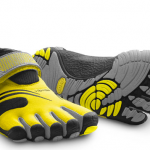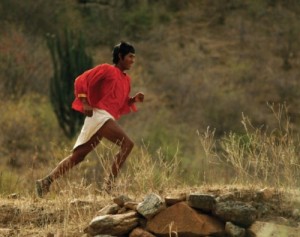In Defense of Sneakers
 I just finally checked out Christopher McDougall’s Born to Run, the bestseller that inspired ultra-marathoners, the grocery store checkout lady, and Matthew McConnaughey to wear toe shoes.
I just finally checked out Christopher McDougall’s Born to Run, the bestseller that inspired ultra-marathoners, the grocery store checkout lady, and Matthew McConnaughey to wear toe shoes.
McDougall argues that cushioned sneakers increase their wearers’ risk of injury more than running barefoot, which forces away bad habits by being crazy painful if done wrong. Around the time the book became a national bestseller, people started wearing thin-soled minimalist running shoes with separated toe-treads that functioned either to simulate the barefoot experience or to use for Creature From The Black Lagoon costumes. As far as I can tell, Born to Run stirred up a craze that has separated people into two categories: 1) those who are so hardcore that they wear minimalist shoes; and 2) those who are so hardcore that they think minimalist shoes are dorky and stupid.
Here’s how a conversation between members of categories 1 and 2 might go:
1: Hey bud! Check out my new treads.
2: They look dumb. Why are your toes all separated?
1: The human foot is made up of hundreds of bones, numerous joints, sensory receptors, ligaments, and tendons. Have you ever taken the time to notice how all of these parts feel?
2: You’re weird.
1: You will wear toe-shoes one day. (Shakes fist.) Oh yes, you will.
I’ll admit, I was a card-carrying member of category two for a long time. I liked to joke about catching glimpses of toe shoes “in the wild” and I would have judged you if you wore them to yoga class. To me, toe shoes were as incomprehensible as seitan burgers might be to a cattle farmer.
But now, after actually reading Born to Run, I want to be one of the Tarahumara tribe of super-marathoner Indians who run hundreds of miles nonstop, wearing only sandals, on some of Mexico’s most rugged terrain. If I was in high school and I had a locker, I’d have this picture taped up inside it:
I was disappointed to learn, however, that even elite marathoners take months and months to train to run like the Tarahumara. Right now, with about three weeks to go before the marathon, I’d have to be crazy to undergo a major change of footwear. But unlike all of the hype surrounding it, the book does not suggest that you have to go out and purchase trendy toe-liberating shoes or experiment with your flip flops to run more efficiently. Instead, the major lessons McDougall offers are much more focused on form than on gear:
- Point your toes downward and strike the ground with your midfoot rather than heel-first
- Keep your stride underneath the upper body
- Spring forward quietly (don’t slap the ground with each step)
So, with all due respect to barefoot and minimalist runners, do I really have to throw away my support Asics? Like, I get that the concept of arch support didn’t exist a hundred years ago, but can’t I keep it now that it’s here? I think it’s still possible to wear my sneakers and practice good technique, and it’s nice to know that I can always fall back on the heel cushioning when my feet get tired. For example, after 20-plus miles of running on hard pavement.

